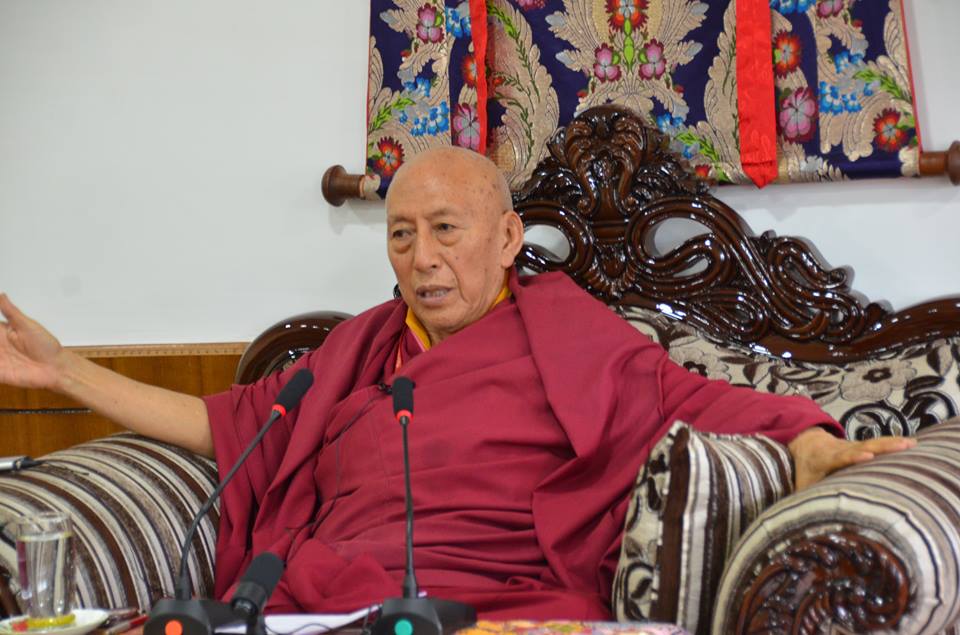A talk on “Tibetan perspectives on death and dying”
2 September 2016, Dharamshala
This afternoon His Eminence Prof. Samdhong Rinpoche kindly gave a talk to the teachers and students of School of Social Work, Tulane University, New Orleans, USA, on the requested topic of “Tibetan perspectives on death and dying, and the importance of having a healthy relationship with this natural part of life,” in the hall of Lha Ahimsa House, Dharamshala.
His Eminence Rinpoche opened the talk with the insights(a) that the topic of death is something of which there is no retrospective recollection by anyone, since death is an unconscious state of the mind, and even in the cases of children or young people remembering their past life experiencesand events there is no recounting of their death experience; remembering takes place with a conscious mind through seeing, hearing, smelling, tasting, feeling; yet we can know descriptions of death, how it comes, how to deal with it, from the teachings of those persons who know everything by their own mature-wisdom, mature-wisdom being the wisdom which is attained after long-term practices and meditations, when the experiences become more clear; it is to be experienced. (b) The “Tibetan perspectives” would be Buddhist perspectives, or classical Indian Buddhist perspectives.
As regards what “death” is, the concept of death, one needs to at first consider how the various spiritual faiths and non-believers have their respective concept of the singularity or separateness of body and mind, those in the former group are such as, the ancient Caravak philosophical tenet of India, for whom body and mind are one akin to a wall and the painting on it, and they professed existence of a single life, devoid of former or next lives continuity, Rinpoche explained.
Thereafter His Eminence Rinpoche continued: Of those propounding separateness of body and mind, when the departing of the mind away from the body takes place, that is described as “death,” and as for what causes this separating of the two there would be variant views of the external cause/s determining such, by the Creationists and non-Creationists, and the Buddhist perspective is that of karmic force which accounts for the person’s lifespan and its expiry as death, the separation of body and mind.
On the actual nature of death, in the Buddhist perspective, His Eminence Rinpoche explained that the process of dying takes place through dissolution of the five aggregates (which make up a person: form, feeling, recognition, karmic action and consciousness) and the four elements—the components of form—and the gross consciousness, culminating in death clear-light state. The stage of external breathing ceasing with a dying person is the stage of dissolution of the wind element (of the four elements: earth, water, fire and wind) and although this is clinically termed as “death” there are still further processes of dying the person goes through, the mind has not yet left the body.
The fear of death is caused by unreasonable negative emotions of attachment and desire, attachment towards things dear to the person, and desire of unfinished things to be completed and so forth, Rinpoche pointed out, and in this connection it is important to not do anything to let rise of these negative emotions in a dying person, His Eminence Rinpoche explained.
 These and many important insights were presented by His Eminence Rinpoche on the understanding of death and its process.
These and many important insights were presented by His Eminence Rinpoche on the understanding of death and its process.
On the second part of the topic of talk requested, that is, “…the importance of having a healthy relationship with this natural part of life,” His Eminence Rinpoche said that death is not the natural part of life, rather it is the end of life, and as such this part of the topic would have been correct if mentioned as “natural end of life.”
There followed Q/A at the end of the talk.
Organised by Lha Charitable Trust—Institute for Social Work and Education, Dharamshala—the Talk was streamed Live; it can be viewed again at Prof. Samdhong Rinpoche’s YouTube Channel.
